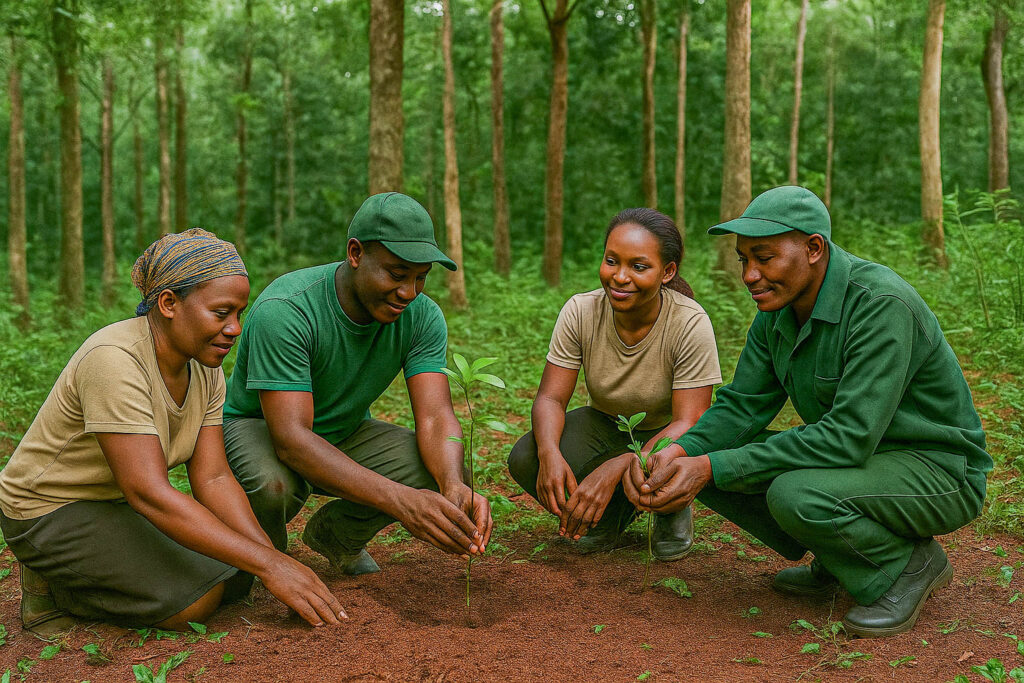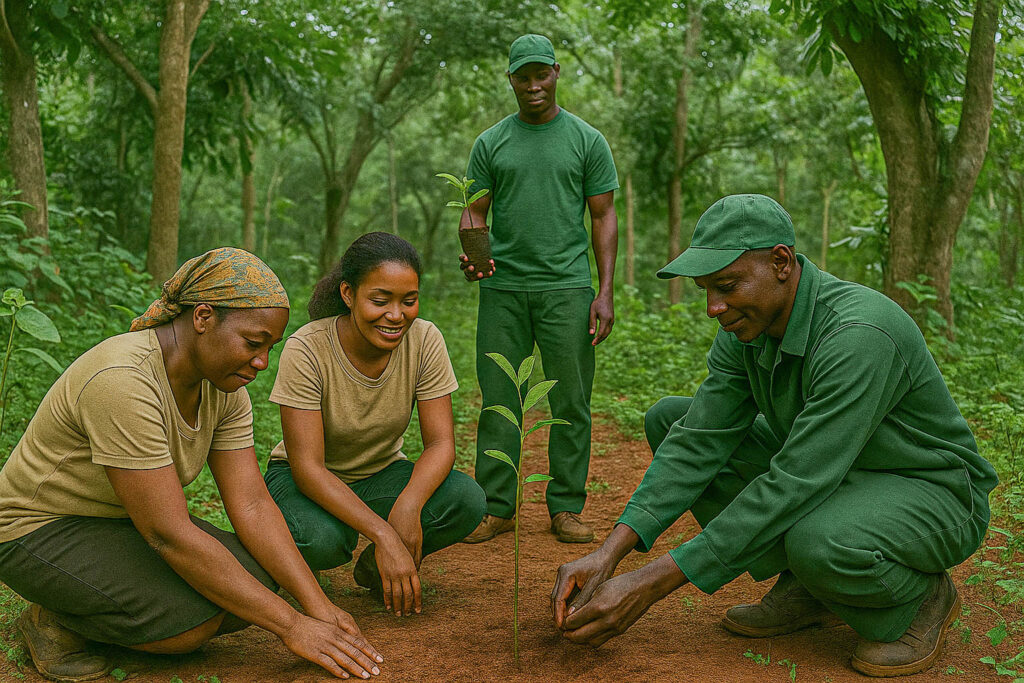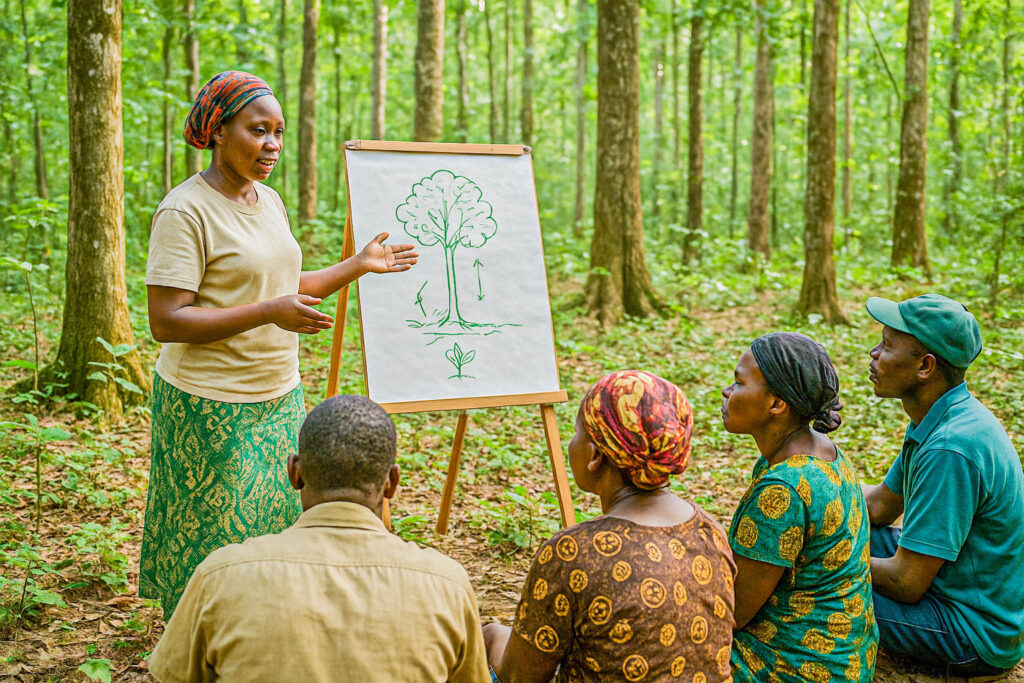Preserving Forest Ecosystems for Climate Stability and Community Prosperity

Forest conservation lies at the heart of our mission to combat climate change while improving community livelihoods. Our comprehensive forest conservation and protection programs recognize that healthy forests are essential for climate regulation, biodiversity preservation, and sustainable development. We work directly with forest-dependent communities, recognizing them as the most effective long-term guardians of forest resources.
Across sub-Saharan Africa, forests face unprecedented pressure from agricultural expansion, infrastructure development, logging, and climate change impacts. Our forest conservation approach addresses these challenges through integrated strategies that combine traditional knowledge with modern conservation science, ensuring both immediate protection and long-term sustainability.
Deforestation Prevention Strategies
Addressing Root Causes of Forest Loss Deforestation is driven by complex socioeconomic factors that require comprehensive solutions. Our prevention strategies focus on understanding and addressing these underlying drivers while providing communities with viable alternatives to forest-destructive practices.
Agricultural Pressure Solutions Since agriculture represents the largest driver of deforestation in our operational areas, we prioritize agricultural intensification and sustainable farming practices:
- Sustainable Agriculture Training: We train farmers in climate-smart agricultural techniques that increase productivity on existing farmland, reducing the need for forest clearing. These include agroforestry systems, improved crop varieties, integrated pest management, and soil conservation practices.
- Alternative Income Generation: We develop forest-friendly income opportunities such as beekeeping, mushroom cultivation, medicinal plant cultivation, and eco-tourism services that provide economic alternatives to forest conversion.
- Land Use Planning: We facilitate participatory land use planning processes that help communities designate areas for agriculture, conservation, and multiple use, ensuring food security while protecting critical forest areas.
Infrastructure Development Management Roads, mining, and urban development create significant deforestation pressure. Our approach includes:
- Early Stakeholder Engagement: We participate in development planning processes to advocate for forest-sensitive infrastructure design and routing that minimizes forest impact.
- Mitigation Measure Implementation: We support the implementation of environmental mitigation measures including wildlife corridors, reforestation offsets, and sustainable construction practices.
- Alternative Development Models: We promote development approaches that work with forest ecosystems rather than replacing them, including forest-based enterprises and green infrastructure.
Policy and Governance Strengthening Weak governance often enables deforestation. Our policy work focuses on:
- Legal Framework Development: We support the creation and implementation of forest laws that balance conservation needs with community rights and economic development.
- Enforcement Capacity Building: We train local authorities and community leaders in forest law enforcement while establishing community-based monitoring systems.
- Transparency and Accountability: We promote transparent forest governance through public information campaigns and community oversight mechanisms.
Protected Area Management
Collaborative Conservation Approaches Effective protected area management requires collaboration between government agencies, local communities, and conservation organizations. Our approach transforms protected areas from exclusionary zones into collaborative conservation spaces that achieve biodiversity goals while respecting community rights.
Management Planning and Implementation We support the development and implementation of comprehensive management plans that integrate conservation objectives with community needs:
- Participatory Planning Processes: We facilitate inclusive planning processes that bring together all stakeholders to develop management strategies that balance conservation goals with community livelihood needs.
- Adaptive Management Systems: We establish monitoring and evaluation systems that allow for continuous improvement of management approaches based on outcomes and changing conditions.
- Resource Mobilization: We help protected areas develop sustainable financing strategies including government budgets, international funding, and revenue generation from sustainable activities.
Community Engagement and Benefit-Sharing Local communities are essential partners in protected area management. Our community engagement strategies include:
- Community Conservation Agreements: We negotiate voluntary agreements with communities that define sustainable resource use practices, conservation commitments, and benefit-sharing arrangements.
- Employment Opportunities: We create direct employment opportunities for community members as forest guards, guides, researchers, and maintenance staff.
- Revenue Sharing: We establish mechanisms for communities to receive direct financial benefits from protected area activities including eco-tourism and research fees.
Capacity Building and Training Effective protected area management requires skilled personnel and strong institutions:
- Staff Training Programs: We provide comprehensive training for protected area staff in areas including biodiversity monitoring, community engagement, conflict resolution, and adaptive management.
- Community Capacity Building: We train community members in conservation techniques, sustainable resource management, and leadership skills.
- Institutional Strengthening: We support the development of strong management institutions with clear roles, responsibilities, and accountability mechanisms.
Community Forest Monitoring
Building Local Capacity for Forest Stewardship Communities living in and around forests are ideally positioned to monitor forest changes and respond to threats. Our community forest monitoring programs build on traditional knowledge while introducing modern tools that enhance communities’ ability to track and protect forest resources.
Traditional Knowledge Integration We begin by documenting and validating traditional forest monitoring systems, recognizing that communities have sophisticated methods for tracking forest health, species populations, and environmental changes:
- Elder Knowledge Documentation: We work with traditional leaders and elders to document traditional forest management and monitoring practices.
- Seasonal Calendar Development: We help communities develop seasonal calendars that track natural cycles, species behavior, and optimal times for various forest activities.
- Traditional Indicator Species: We identify and train communities to monitor traditional indicator species that signal forest health and environmental changes.
Modern Technology Training We provide communities with modern monitoring tools and comprehensive training:
- GPS and Mobile Applications: Community monitors learn to use GPS units and smartphone applications to record precise locations of forest changes, illegal activities, and biodiversity observations.
- Satellite Imagery Analysis: We train community members to interpret satellite images to identify deforestation patterns, forest degradation, and recovery trends over time.
- Data Collection Systems: Communities learn to use standardized data collection protocols that ensure information can be analyzed and compared across different areas and time periods.
- Reporting and Communication: We establish communication systems that allow communities to quickly report urgent forest threats to relevant authorities.
Early Warning and Response Systems Community monitors form the foundation of early warning systems that can rapidly detect and respond to forest threats:
- Threat Detection Networks: Trained monitors establish regular patrol routes and observation points to detect illegal activities, fires, and other forest threats.
- Rapid Response Protocols: We establish clear protocols for community response to different types of forest threats, including coordination with government agencies and law enforcement.
- Community Alert Systems: We implement communication systems that allow rapid information sharing between communities and coordination of response efforts.
Biodiversity Conservation
Protecting Forest Ecosystems and Species Forest biodiversity is essential for ecosystem stability, resilience, and the provision of services that communities depend on. Our biodiversity conservation approach integrates scientific conservation priorities with community knowledge and needs to protect critical species and habitats.
Habitat Protection and Restoration We work with communities to identify and protect critical habitats while restoring degraded areas:
- Priority Area Identification: Using both scientific assessments and community knowledge to identify areas of highest conservation value, including critical habitats for endangered species and important ecological corridors.
- Restoration Planning: Developing restoration plans for degraded areas that maximize biodiversity benefits while providing sustainable resources for communities.
- Native Species Reforestation: Supporting the planting of native tree species that provide wildlife habitat while producing valuable products such as fruits, medicines, and construction materials.
- Corridor Establishment: Creating forest corridors that connect fragmented habitats, allowing wildlife movement and maintaining genetic diversity.
Species Conservation Programs We develop targeted conservation programs for threatened and culturally important species:
- Flagship Species Protection: Working with communities to protect charismatic species that serve as umbrella species for broader ecosystem conservation.
- Traditional Species Management: Supporting traditional management systems for culturally important species while enhancing their effectiveness with modern conservation techniques.
- Anti-Poaching Initiatives: Developing community-based anti-poaching programs that address the root causes of poaching while protecting vulnerable species.
- Human-Wildlife Conflict Resolution: Implementing strategies to reduce conflicts between communities and wildlife, including early warning systems, physical barriers, and compensation mechanisms.
Community-Based Conservation Local communities are the most effective long-term stewards of biodiversity:
- Conservation Agreements: Negotiating voluntary conservation agreements with communities that define conservation commitments and benefit-sharing arrangements.
- Community Conservancies: Supporting communities to establish and manage their own conservancies for important species and habitats.
- Traditional Governance Support: Strengthening traditional governance systems that have historically managed forest resources sustainably.
- Biodiversity Monitoring Training: Training community members to monitor wildlife populations, habitat conditions, and threats to biodiversity.
Integrated Approach and Measurable Impact
Synergistic Conservation Strategies Our forest conservation and protection work achieves maximum impact through the integration of all four strategies. Deforestation prevention addresses immediate threats and underlying drivers, protected area management creates secure conservation spaces, community monitoring provides ongoing surveillance and early warning, and biodiversity conservation maintains ecosystem integrity and resilience.
Adaptive Management and Continuous Learning We employ adaptive management approaches that allow us to continuously improve our strategies based on monitoring results, community feedback, and changing environmental conditions. This includes regular strategy reviews, stakeholder consultations, and incorporation of new scientific knowledge and best practices.
Measurable Conservation Outcomes Our integrated forest conservation approach has achieved significant measurable results across our operational areas:
- Forest Cover Protection: Maintained or increased forest cover in 85% of our target areas, with an average 12% increase in forest cover in restoration sites.
- Deforestation Reduction: Achieved an average 67% reduction in deforestation rates in areas where we implement comprehensive prevention strategies.
- Protected Area Effectiveness: Improved management effectiveness scores by an average of 40% in protected areas where we provide support.
- Community Capacity: Trained over 750 community monitors who are actively involved in forest surveillance and protection activities.
- Biodiversity Recovery: Documented population increases for key indicator species in 78% of our conservation sites, with particularly strong recovery of bird and primate populations.
- Economic Benefits: Generated over $890,000 in direct income for communities through forest-based enterprises and conservation employment opportunities.
Long-term Sustainability and Replication Our forest conservation programs are designed for long-term sustainability and replication in new areas. We build local capacity, establish sustainable financing mechanisms, and document lessons learned to enable scaling of successful approaches. Through partnerships with government agencies, other NGOs, and international organizations, we work to influence policy and practice beyond our direct operational areas.
Climate Change Contribution Our forest conservation and protection work contributes significantly to climate change mitigation and adaptation. Protected and restored forests sequester carbon, regulate local and regional climate, and provide essential ecosystem services that help communities adapt to climate change impacts. Through our forest conservation programs, we have contributed to the sequestration of over 1.8 million tons of CO₂ equivalent while enhancing the climate resilience of forest ecosystems and dependent communities.
Forest conservation and protection remain central to achieving our mission of combating climate change while improving community livelihoods. Through our integrated, community-centered approach, we demonstrate that effective conservation creates opportunities rather than restrictions, builds resilience rather than vulnerability, and generates benefits that extend far beyond forest boundaries.






Responses